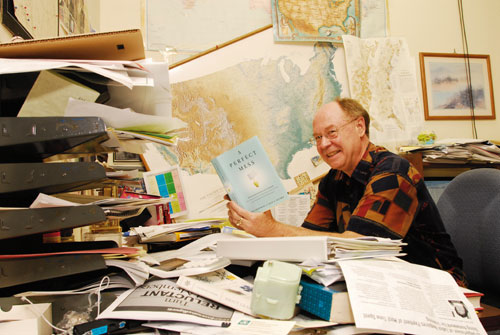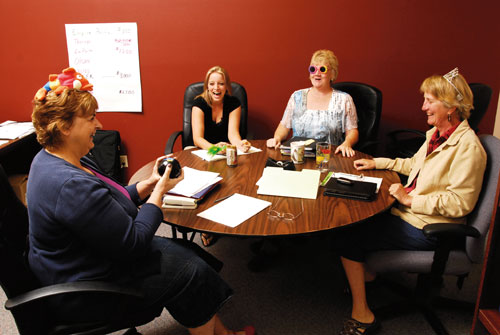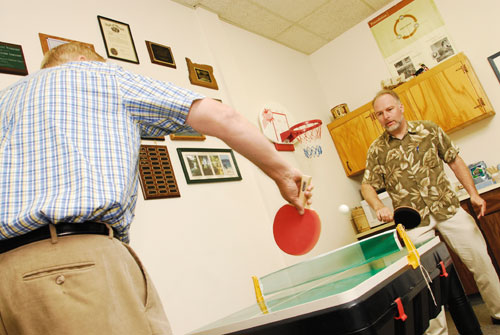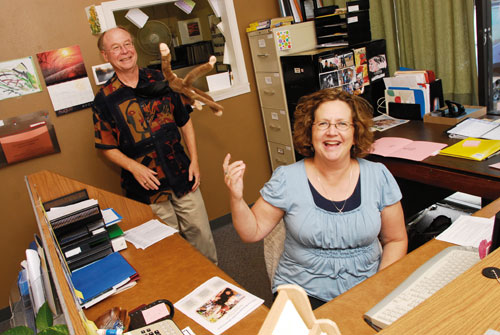 Tucked into a generic strip of offices off a heavily trafficked road in Salem, the Oregon Rehabilitation Center feels like the kind of place where every penny of the $1 million annual budget counts. But underneath that thrift runs a rich sense of cooperation and cheer. Because at the heart of it, these people like each other.
Tucked into a generic strip of offices off a heavily trafficked road in Salem, the Oregon Rehabilitation Center feels like the kind of place where every penny of the $1 million annual budget counts. But underneath that thrift runs a rich sense of cooperation and cheer. Because at the heart of it, these people like each other.
No. 1 Best Small Nonprofit: Oregon Rehabilitation Association
STORY BY LUCY BURNINGHAM // PHOTOS BY ANTHONY PIDGEON
 |
Executive director Tim Kral calls his famously messy desk his “horizontal filing system.” |
Every Monday morning, the 10-person staff of the Oregon Rehabilitation Association huddles around a conference table in a windowless room filled with a large brown fridge, ping-pong table and 7 Habits of Highly Successful People posters. For an hour and a half, they share schedules, review ongoing projects and talk about their weekends. And they laugh.
Tucked into a generic strip of offices off a heavily trafficked road in Salem, the nonprofit feels like the kind of place where every penny of the $1 million annual budget counts. But underneath that thrift runs a rich sense of cooperation and cheer. Because at the heart of it, these people like each other.
The ORA operates under the mission to support nonprofit organizations around the state that provide services to people with disabilities. That support translates to coordinating conferences and training sessions, lobbying the state Legislature, and providing technical assistance to a core group of 60 nonprofit “members.”
Members pay annual dues to receive services from the ORA, which results in two-thirds of the organization’s budget. The ORA’s support helps members provide jobs, housing and care for people with disabilities.
 |
Staffers Marianne Davis, Brittney Standish, Vicki Devlin and Karen Craven share a laugh. |
While the staff rallies around the mission — half of them have worked with people with disabilities in past jobs — the nature of the workplace has helped retain many of the employees for extraordinary lengths of time.
Six salaried employees have been with the organization for between 10 and 24 years. Each was hired when their position was created and has remained there ever since.
Marketing representative Bruce Gordon calls himself “the newbie,” as he approaches his 10-year anniversary in the office. Marketing director Stephen Mock was hired right out of college — 17 years ago. And executive director Tim Kral wrote the initial grant for his own position in 1985, which transformed the ORA from an all-volunteer group (founded in 1967) to today’s operation.
Admin assistant Brittney Standish left ORA after a year and a half for another job, but says she immediately felt “an empty spot.” Eventually, she decided to return and was rehired this past May.
“There’s never a conversation here that doesn’t involve helping someone,” Standish says. “It’s rewarding coming to work knowing people really do care and that it’s truly from the heart. Besides, everyone here feels like family.”
 |
Bruce Gordon and Corey Jeppesen battle it out in a game of office Ping Pong. |
The notion of family resonates with everyone on staff; they’ve watched each other’s kids grow up and shared paid sick time during emergencies.
This summer, a few employees decided to go camping together with their families. Soon, everyone in the office wanted to go, so the ORA picked up the camp fee. “It’s not often you have all your co-workers say, ‘Let’s all go camping together for fun,’” Mock says.
Much of the fun factor originates in the office, where Kral recently handed out plastic teeth to staffers in order to surprise a visitor with their shocking grins. During quiet moments, he’s been known to lob a screaming monkey toy at employees, and makes sure meetings include time for impromptu humor.
The lighter side of the workplace can exist because of the staff’s work ethic and their genuine commitment to the mission, he says.
As a manager, Kral believes as much in attention to detail as the big picture. In his office, above the sea of organized paper chaos he calls his “horizontal filing system,” a map of Oregon stuck with pins for each member hangs close to a poster about black holes.
“I’m big into perspective,” he says.
 |
Monkey business comes with the territory for Tim Kral and Marian Gordon. |
Many ORA employees tap into the larger meaning of their work on the road, when they visit members located everywhere from Coos Bay to Klamath Falls (more conveniently, 70% of members are in the Willamette Valley).
“When I travel, I meet some of the people who derive the benefits of what we do,” says Bruce Gordon. “Those folks wouldn’t be able to work were it not for these programs.”
At the weekly Monday meeting, staffers will arrange to tag-team projects to make trips as efficient as possible.
The statewide programs will always need the ORA, says Kral, especially as they shift from the group-home approach to systems designed to support individuals who are living longer and becoming better educated and increasingly independent.
In other words, the ORA isn’t going anywhere. And based on the amount of laughter floating around the office, neither is the staff.




